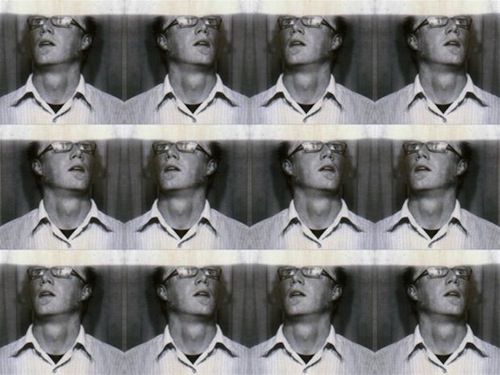Resisting the Poem of the Moment: Failure and Sincerity in the Work of Tao Lin, Matt Hart, Dorothea Lasky, and Others

Jacket2 has more than "something that stutters sincerely" in their new post on contemporary poetry and the aesthetics of failure. Jennifer Moore's paper looks closely at writers Tao Lin and Matt Hart, but she begins by stating that:
I am interested in how the work of poets like Matt Hart, Tao Lin, Dorothea Lasky, and Nate Pritts, among others, is engaged with notions of risk and failure, and I want to suggest that by adopting “failure” as an aesthetic stance, they are claiming a kind of paradoxical literary authority.
Moore makes incredibly interesting connections between Lin and Hart, two writers not necessarily thought of together:
A poem without emotional weight (“cerebral”), and thus without consequence, is what poets like Hart, Lin, and others are resisting; they are deliberately rejecting the “Poem of Our Moment” by testing the limits of sentimentality while still adhering to experimental techniques. Hart’s Who’s Who Vivid...exemplifies this friction between the avant-garde and the lyric tradition it sought to criticize. Where he is lyric (subjective voice, emotional expression), he tends to destabilize himself by either refusing subjective identification or by turning authentic expression into inauthentic sentimentality. Where he borrows from the preceding generation’s avant-garde (procedural techniques, alphabet exercises, fragmented syntax, blurring of the “poetic” with other discourses, collage-like assemblages), he tends to produce poems that feel like linguistic exercises with little relevance beyond their own boundaries. The success of Who’s Who Vivid, then, rests on Hart’s ability to balance these two impulses through continually undermining each.
What's the "Poem of our Moment"? Here Moore refers to Tony Hoagland in his article “Fear of Narrative and the Skittery Poem of Our Moment," where he defined it as:
fast-moving and declarative, wobbling on the balance beam between associative and dissociative, somewhat absurdist, and, indeed, cerebral. Much talent and skill are evident in its making, in its pacing and management of gaps, the hints and sound bites which keep the reader reaching forward for the lynchpin of coherence … it seems capable of incorporating anything … yet all this motley data — i.e. experience — doesn’t add up to a story. Even as the poem implies a world without sequence, the poem itself has no consequence, no center of gravity, no body, no assertion of emotional value.
And so there is a feeling that these poets have "see[n] postmodernist poetics as having reached its limit." Earlier, Moore notes that: "Jason Morris is representative of this sense when he notes that a recent upsurge in 'sincere' tones and earnest depictions of emotionality 'seem to be immanent critiques of irony,' and that 'contemporary poetry has so fully digested irony that it’s ready and willing to discuss it openly—‘sincerely’—in plain view.”
She goes on to look at the idea of risk in the form of sentiment; Hart and Lin's articulations of their own processes; and what kinds of labels and groups are apt to form around stated resistances and "new sincerities"; the poets' reactions to such labeling (“New Sincerity … uh? I have no idea what the Old Sincerity was …”, said Hart); and critical responses to the work, which tend toward the extreme. Elisa Gabbert, at one point, identifies their mode of writing as:
“a ‘cultivated artful artlessness’ in tone employed by artists like Tao Lin, Joanna Newsom and Dorothea Lasky … this childish tone can be employed to great dramatic effect — creating ‘insta-intensity’ … [and] tends to inspire love-it-or-hate-it reactions in people.” If Hart sees his poetry as a form of risk-taking, Gabbert argues that this mode might actually be a means of defending oneself against critique: “I’ve sung the praises of Lin and Lasky here before … [but] there’s something preemptively defensive about this Innocent mode — as though by announcing upfront one’s vulnerability, one could become invulnerable. As in, Don’t hurt me, I’m just a kid.” This characterization seems to recall DeDeo’s complaint about Lin’s allegedly “masculine, fuck you, attitude” as well. What this ends up looking like (although the above statements are all responses to the work rather than examples of it) is an aesthetics of posture and stylization rather than authentic emotional expression; indeed, the antithesis of sincerity.
Moore then writes about Tao Lin's "dead-pan" style, his "technique of omission," and his book Cognitive-Behavioral Therapy. She also frames much of her thinking with an essay by Christian Bök called “Writing and Failure," which highlights much of what she's after:
What is at stake here is a longstanding question — how we can determine whether something is art or not — and more specifically, whether “bad” techniques can serve to revitalize stagnant art. These are questions that have been asked at least since the twentieth century was confronted with Dada and surrealism and later, conceptual art.
The idea that the avant-garde is responsible for pushing the limits of what can be considered art comes with a risk, when the question of definition — what makes something art? — seems necessary to ask of those objects that clearly do not seem to be performing in the ways we think they should perform. What is notable about this particular situation involving Hart, Lin and others is both its mode (childish discourse, sentimentality) and its motive or object of resistance (Language writing and its second-generation adherents, the “post-avant”). But the desire to create art that deliberately fails by certain standards means that it intends to succeed by others.
Read this great essay in full here; and perhaps decide for yourself which poem or mode of which moment is resisting which poem or mode of which moment...


